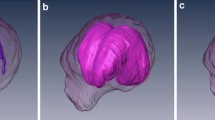Summary
In an attempt to study the use and value in ventriculography of meglumine iocarmate (Dimer-X), previously accepted as a water soluble contrast medium safe for myelography, we have conducted animal experiments to compare Dimer-X with meglumine iothalamate (Conray 60) and meglumine diatrizoate (Angiografin). We also made clinical studies of Dimer-X.
In the animal experiments, 1.5 ml and 2.0 ml of Dimer-X were injected into the ventricles of 7 dogs. We noted the apparent superiority of Dimer-X over Conray 60 and Angiografin as far as side effects were concerned, but there were no particular differences in the intensities of the ventriculograms obtained. Morphological studies of the ventricles and histological examinations of the ventricular walls 1 month after intraventricular injections of Dimer-X showed no abnormalities.
In the clinical studies, ventriculography with 1–5 ml Dimer-X, performed on 17 cases, aged 8 months to 62 years, with diseases of the central nervous system, produced ventriculograms of good diagnostic value with no side effects, such as convulsions, apart from mild headache or vomiting in 4 instances.
Similar content being viewed by others
References
Gonsette, R., An experimental and clinical assessment of water-soluble contrast medium in neuroradiology. A new medium—Dimer-X. Clin. Radiol.22 (1971), 44–56.
Hammer, B., Scherrer, H., Choice of contrast medium in lumbosacral myelography. Neuroradiology4 (1972), 114–117.
Kunze, St., Klinger, M., Schiefer, W., Central ventriculography with Dimer-X. Acta Neurochir.28 (1973), 41–63.
Löser, R., Vogelsang, H., Angiografin auch bei der lumbalsn Myelographie anwendbar? Fortschr. Röntgenstr.118 (1973), 654–657.
Mita, R., Kawaguchi, S., Suzuki, S., Ottomo, M., Iwabuchi, T., Angiografin ventriculography. Clinical study (2nd report). Jap.-Dtsch. Med. Ber.18 (1973), 557–584.
Occleshaw, J. V., Hoyland, J. N., Comparative study of the effects of Conray 280 and Dimer-X in lumbar radiculography. Brit. J. Radiol.44 (1971), 946–948.
Pertuiset, B., Metzger, J., Houteville, J. P., Caruel, N., Ernest, C., Indications et résultats de la ventriculographie cérébrale au sel de méthylglucamine du Dimer iotalamique. Revue Neurologique126 (1972), 299–304.
Reinhardt, K., Zufällige thorakale Myelographie mit Dimer X. Fortschr. Röntgenstr.118 (1973), 477–478.
Suzuki, S., Kawaguchi, S., Mita, R., Ito, K., Iwabuchi, T., Angiografin ventriculography. Experimental study in the dogs (1st report). Jap.-Dtsch. Med. Ber.18 (1973), 392–397.
Author information
Authors and Affiliations
Rights and permissions
About this article
Cite this article
Suzuki, S., Kawaguchi, S., Mita, R. et al. Ventriculography with methylglucamine iocarmate (Dimer-X). Acta neurochir 33, 219–231 (1976). https://doi.org/10.1007/BF01886671
Issue Date:
DOI: https://doi.org/10.1007/BF01886671




